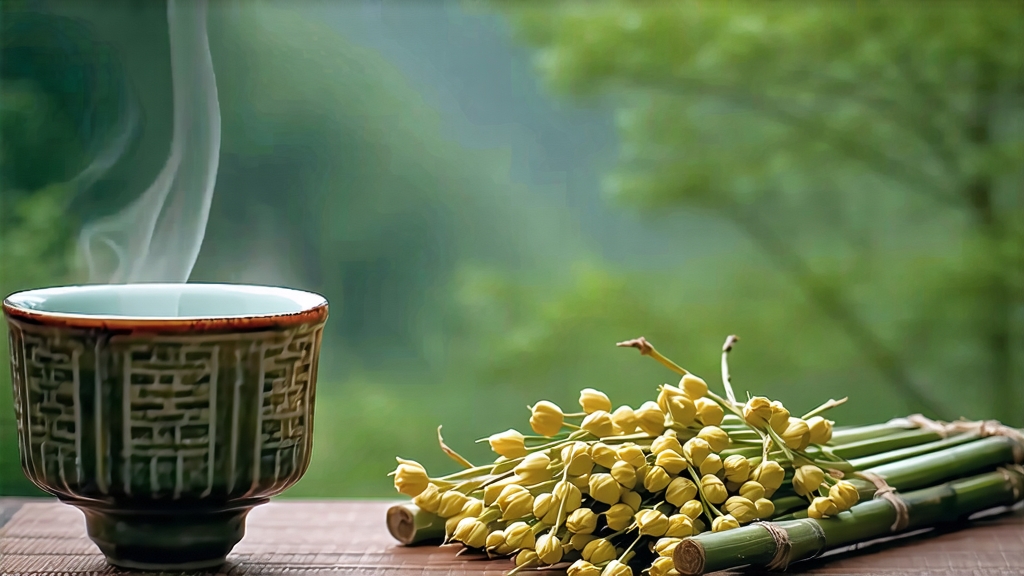
Tucked high on the mist-locked Meng Ding Mountain in Sichuan Province, Meng Ding Huang Ya has been whispered about in Chinese tea texts for more than twelve centuries. Legend credits the Buddhist monk Wu Li-zhen with planting the first seven tea bushes on the summit in 53 BCE; by the Tang dynasty (618-907 CE) those bushes, known as the “immortal tea plants,” were already paying tribute to the imperial court. When Song emperor Huizong rhapsodized about “golden buds among the clouds,” court chroniclers believe he was describing the very same hand-picked shoots that still emerge after the early-spring snowmelt. After a quiet eclipse during the Ming and Qing, the 1950s saw state tea institutes revive the craft, and today Meng Ding Huang Ya is the benchmark yellow tea against which all others are judged.
Although yellow tea is often lumped together with green, the category is defined by one extra, almost alchemical step: sealed yellowing (men huang). In Meng Ding Huang Ya this step is performed twice, giving the leaf a luminous straw-gold color and a flavor that slides from brisk to buttered without ever drifting into the grassy bite of green tea. The cultivar of choice is the local “Meng Ding #9,” a small-leaf Camellia sinensis var. sinensis selected for its high amino-acid core and slow winter dormancy. Only the unopened bud or the bud-with-just-one-leaf standard is acceptable; plucking begins when 5 % of the garden’s shoots reach 1.5–2 cm, usually between 20 March and 5 April. A master picker can finish 500 g of fresh buds in four hours—enough, after firing, to yield a mere 100 g of finished tea.
The craft protocol, unchanged since 1958, unfolds over four dawn-to-dusk days. First, pan-firing (sha qing) is done on a 140 °C bronze wok brushed with fresh rapeseed oil; 120 g of buds are tossed for 3.5 minutes until their moisture drops to 55 %. While still warm, the leaf is wrapped in three layers—traditional yellow kraft paper, a linen cloth, and a thin bamboo mat—then placed in a 28 °C humidity cabinet for 48 hours. During this first men huang the leaf oxidizes micro-aerobically, turning from jade to pale champagne and developing the signature cocoa-like note. A second, gentler firing at 90 °C for six minutes sets the color, followed by another 24-hour wrapped rest. Finally, the leaf is charcoal-baked at 60 °C for four hours while the baker rhythmically taps the bamboo tray, a motion said to “knock the mountain mist” into the bud. The finished tea is judged by three gold standards: every bud must stand upright when dropped into a glass of water, the liquor must ring clear like topaz, and the wet leaf must release the scent of fresh lychee.
To unlock these qualities, water is everything. Source spring water from the same Min River system if possible; its moderate mineral content (80–120 ppm TDS) flares the buds open without dulling brightness. Pre-heat a tall glass or a 150 ml gaiwan; use 3 g of leaf (roughly 40 buds) for every 100 ml. The first infusion, 75 °C for 45 seconds, is a “wake-up rinse” discarded to the aroma cup; from the second infusion onward, steep 70 °C for 60 seconds, adding 15 seconds each subsequent round. A properly brewed Meng Ding Huang Ya will deliver five clean infusions: the second shows sweet magnolia, the third fresh cream, the fourth ripe apricot, and the fifth a return to mountain stone and faint minerality. If you prefer Western-style brewing, 2 g per 250 ml at 80 °C for three minutes gives a round, honeyed cup, but you forfeit the vertical journey of aromas that gongfu brewing reveals.
Tasting follows a quiet choreography. First listen: when the hot water meets the buds, a faint crackling—locals call it “the song of the immortal”—should be audible. Next observe the upright dance; within 90 seconds every bud should drift stem-downward like a miniature glass chandelier. Inhale the cup lip: top notes are orchid and raw almond, base notes steamed maize.